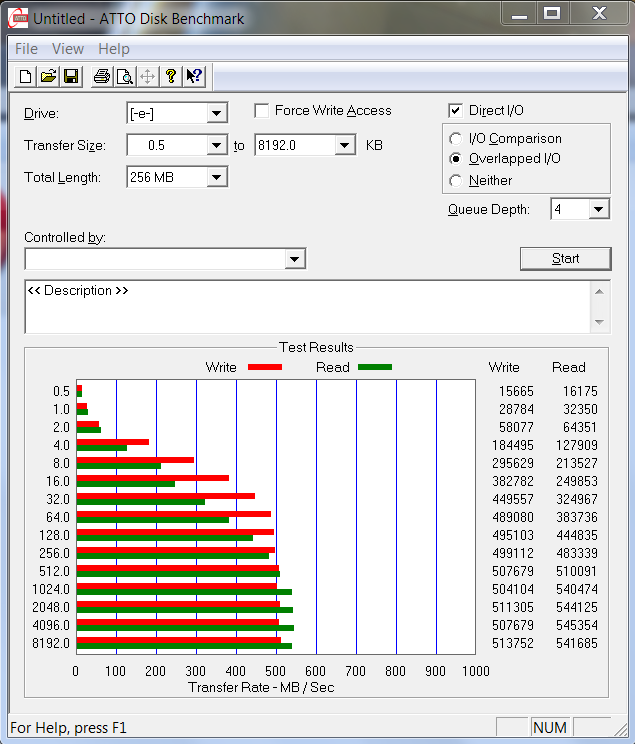ATTO Disk Benchmark is perhaps one of the oldest benchmarks going and is definitely the main staple for manufacturer performance specifications. ATTO uses RAW or compressible data and, for our benchmarks, we use a set length of 256mb and test both the read and write performance of various transfer sizes ranging from 0.5 to 8192kb. Manufacturers prefer this method of testing as it deals with raw (compressible) data rather than random (includes incompressible data) which, although more realistic, results in lower performance results.
 Kingston’s listed specs are 535MB/s read and 480MB/s write which we thought were a bit conservative and the ATTO return of 541MB/s read and 513MB/s write confirm such. These are excellent results.
Kingston’s listed specs are 535MB/s read and 480MB/s write which we thought were a bit conservative and the ATTO return of 541MB/s read and 513MB/s write confirm such. These are excellent results.
CRYSTAL DISK BENCHMARK VER. 3.0 X64
Crystal Disk Benchmark is used to measure read and write performance through sampling of raw (0/1 Fill/compressible) or random data which is, for the most part, incompressible. Many new SandForce Driven SSD owners who cant wait to test the performance of their SSD often grab this program and run a quick test, not realizing that they are testing with incompressible data rather than compressible data used in testing by manufacturers. We have provided compressible (oFill) results on the left with incompressible (random data) results on the right.

 It is here that we actually see the difference between premium NAND, as we saw in the Kingston HyperX, and the value minded memory of the SSDVNow V+ 200. With asynchronous memory, the transfer speeds when moving highly incompressible data are much lower than that of Toggle mode or synchronous memory. A quick look at these HyperX results will clearly display the difference.
It is here that we actually see the difference between premium NAND, as we saw in the Kingston HyperX, and the value minded memory of the SSDVNow V+ 200. With asynchronous memory, the transfer speeds when moving highly incompressible data are much lower than that of Toggle mode or synchronous memory. A quick look at these HyperX results will clearly display the difference.
AS SSD BENCHMARK VER 1.64
Up until recently, AS SSD was the only benchmark created specifically for SSD testing and it uses incompressible data. AS SSD, for the most part, gives us the worst case scenario in SSD transfer speeds while using SandForce Driven SSDs as they use compression in storage as discussed earlier. Many enthusiasts like to benchmark with AS SSD for their needs.
 Once again, we see similar results in testing with incompressible data as AS SSD does. This may create hesitation in some which it shouldn’t. The simple truth is that, if you are just migrating to SSD from hard drive and have no ‘specific’ demanding tasks for the drive, nobody can tell the difference in any of today’s solid state drives in typical daily use.
Once again, we see similar results in testing with incompressible data as AS SSD does. This may create hesitation in some which it shouldn’t. The simple truth is that, if you are just migrating to SSD from hard drive and have no ‘specific’ demanding tasks for the drive, nobody can tell the difference in any of today’s solid state drives in typical daily use.
The visible speed boost seen when migrating to a SSD from a hard drive, however, is incredible. For example, the average computer takes about a minute and a half to two minutes to start. The typical ‘SSD enhanced’ system takes 20 seconds.
It’s just that fast!
 The SSD Review The Worlds Dedicated SSD Education and Review Resource |
The SSD Review The Worlds Dedicated SSD Education and Review Resource | 
not reliable at all… i bough my HyperX on Jan 2012… last week sent back for warranty…. cannot detect, yet have to wait for 4 weeks for the replacement stock to arrived from Taiwan…. very bad backup service…..
Works like a charm! Bought the V+200 240 gb to upgrade from macbook pro (early 2011) factory toshiba 128gb ssd. Great speed. It’s been 2 months, not one problem. Easy install, just needed to fill some voids for correct seating of the ssd into the laptop. Got it on discount $170 for the 240gb. yahoo.
I suposse not two months, two minutes else 😉